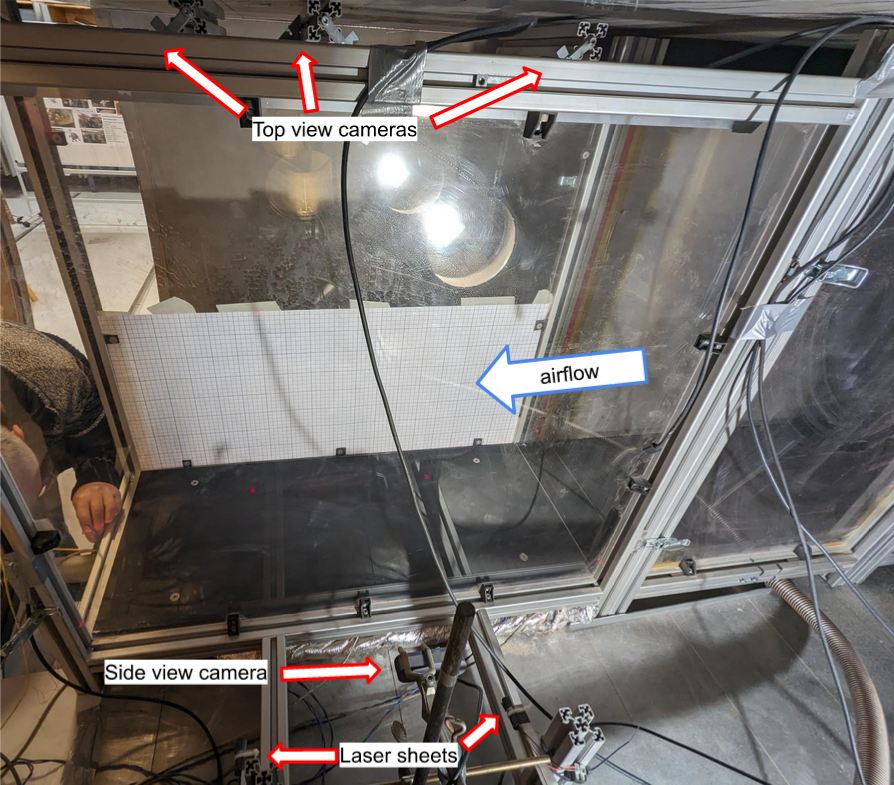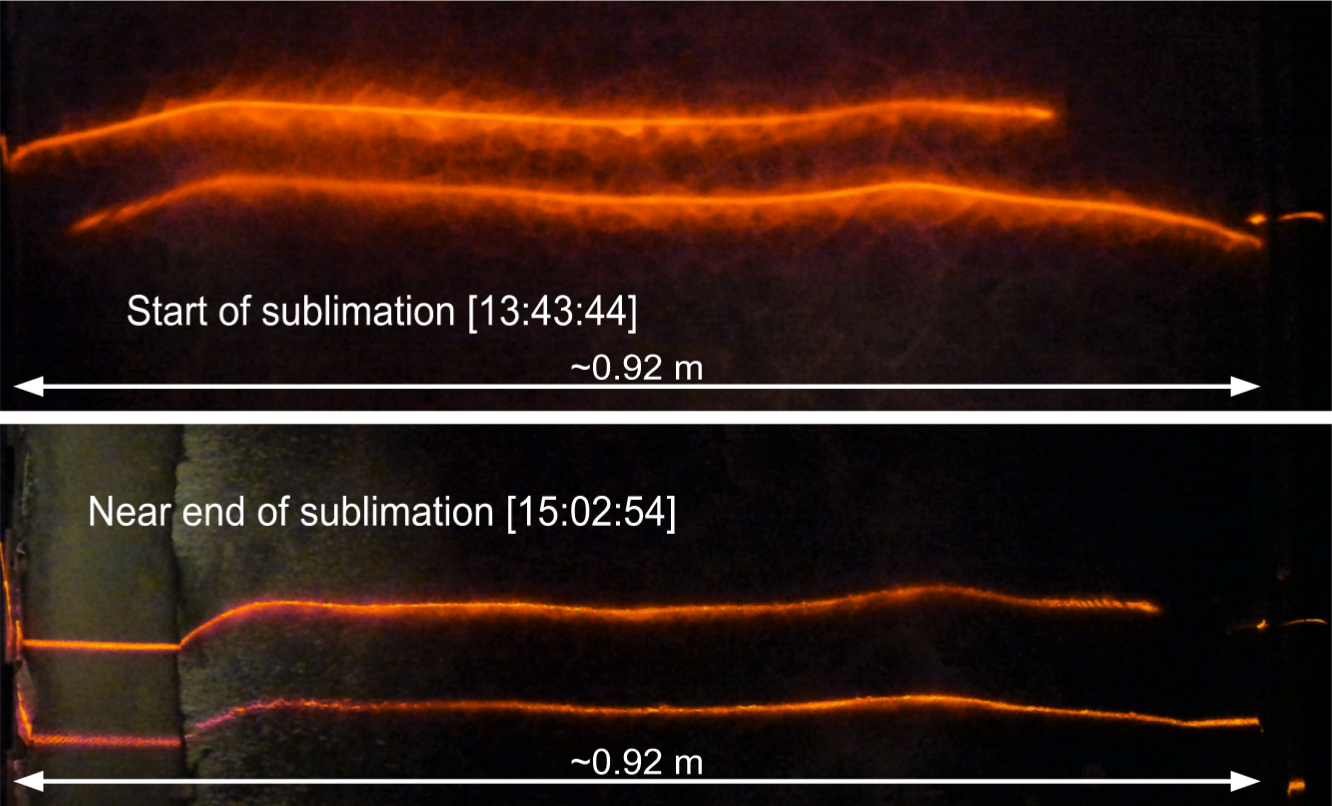Aarhus Wind Tunnel Simulator II experiments on CO2 ice show sublimation instability and frost migration
- 1Laboratoire de Planétologie et Géosciences, Université de Nantes, Université d'Angers, CNRS, UMR 6112, Nantes, France
- 2Physique et Mécanique des Milieux Hétérogènes, UMR 7636 CNRS - ESPCI Paris – Univ. PSL - Univ. Paris Cité – Sorbonne Univ., 10 rue Vauquelin, 75005 Paris, France
- 3Department of Physics and Astronomy, Aarhus University, 8000 Aarhus C, Denmark
- 4Laboratoire de recherche en Hydrodynamique, Énergétique et Environnement Atmosphérique, Centrale Nantes, CNRS, UMR 6598, Nantes, France
- 5LESIA, Observatoire de Paris, Université PSL, Sorbonne Université, Université de Paris, CNRS, Meudon, France
In the proposed oral presentation, we will report on the first results of our latest experimental campaign in the Aarhus Wind Tunnel Simulator II. The campaign took place in March 2024, with the goal of observing the evolution of the surface morphology of a slab of CO2 ice that is sublimating away, being exposed to different wind speeds and atmosphere configurations.
The phenomenon we were looking for are so-called “sublimation waves”. These are transverse ripples or scallops that emerge on icy substrates under the influence of wind-driven sublimation. The emergent wavelength, migration velocity and formation timescale of confirmed sublimation waves on the Blue Ice Areas in Antarctica [Weller, 1969; Mellor and Swithinbank, 1989; Bintanja et al, 2001], on walls of ice caves [Curl, 1966] and on the Martian North Polar Cap [Bordiec et al, 2020] can be linked through a set of scaling laws derived from a linear instability analysis [Claudin et al, 2017] of the turbulent boundary layer flow over a sublimating substrate [Bordiec et al, 2020; Carpy 2023].
If the scaling laws were validated systematically, remote observation of bedforms could be used to map the prevailing surface winds on planets with icy surfaces, without the need for in-situ measurements. This could provide new constraints for global circulation models over ice surfaces like on Pluto. Thus the presented experimental campaign in the AWTS-II investigated the sublimating behaviour of CO2 ice under varying flow viscosity and velocity, to compare with behaviour predicted by the sublimation wave scaling laws. Our experiment campaign follows up on earlier sublimation experiments on CO2 ice at the Aarhus Planetary Environment Facility. As previous attempts suffered from the heterogeneity of the substrate, being composed of blocks of dry ice (frozen CO2, made from compacted snow and thus opaque), this time we could form the CO2 ice slab through direct deposition of CO2 gas onto a cold plate.

Figure 1: Experimental set-up of test-section inside the AWTS-II wind tunnel chamber.

Figure 2: Comparison of initial and final laser sheet profilometry traces from experiment run 5, central top view camera
The experimental set-up of the test section inside the AWTS-II wind tunnel is shown in Figure 1, with the positions of cameras and laser sheets annotated. We monitored the ice surface evolution using a laser profilometry set-up, see Figure 2 for an example of the image data obtained. During some experiments, we observed how the ice surface developed structures with a length scale of roughly 20 cm, as can be seen for experiment run nr. 5 in Figure 2. During the oral presentation we will present the data obtained from numerical analysis of the laser sheet images and touch upon improvements of the experiment set-up and procedure that were implemented in our experiment campaign.
Another phenomenon that was observed during the experiments on CO2 ice was the appearance and migration of longitudinal frost streaks as well as transverse “frost waves” over the ice surface. An explanation for the observed behaviour includes slow growth of frost through direct deposition, until a critical thickness is reached. At this thickness the aerodynamic loads on a frost flake overcome its sticking force, causing it to break away from the surface and fly off in the flow. The cycle of frost growth and removal by flaking made both frost features appear to migrate downstream at speeds of several mm/min. In addition to sublimation waves, evolution frost features could provide additional information on wind intensity and direction.
ACKNOWLEDGMENTS: This work has been funded by the ANR grants Pluto’s SHERPAS ANR-23-CE49-0006-02 and Europlanet grant 22-EPN3-073. Europlanet 2024 Research Infrastructure has received funding from the European Union's Horizon 2020 research and innovation programme under grant agreement No 654208.
REFERENCES: Bordiec, M. et al. (2020) Earth & Sci. Reviews. Sci., 103350 ; Weller, G. (1969) Journal of Glaciology, 8(53) :277–284 ; Mellor, M. et al. (1989) Technical report, Hanover NH ; Bintanja, et al. (2001) Journal of Glaciology, 47(158) :387–396 ; Curl (1966) Transactions Cave Research Group of Great Britain, 7(2) : 121–160 ; Claudin, P. et al. (2017) J. Fluid Mech. 832, R2; Carpy, S. et al. (2023) Frontiers in Astronomy and Space Sciences, 10;
How to cite: Eckstein, P., Carpy, S., Claudin, P., Merrison, J., Iversen, J. J., Perret, L., and Bertrand, T.: Aarhus Wind Tunnel Simulator II experiments on CO2 ice show sublimation instability and frost migration, Europlanet Science Congress 2024, Berlin, Germany, 8–13 Sep 2024, EPSC2024-969, https://doi.org/10.5194/epsc2024-969, 2024.